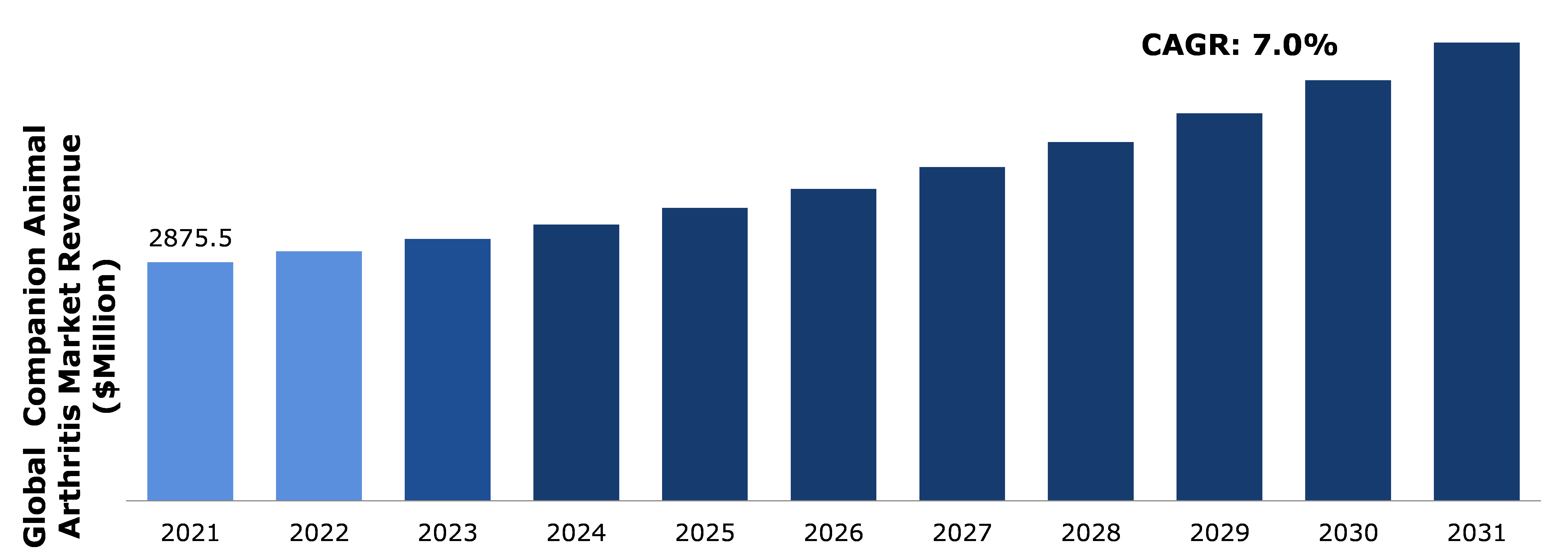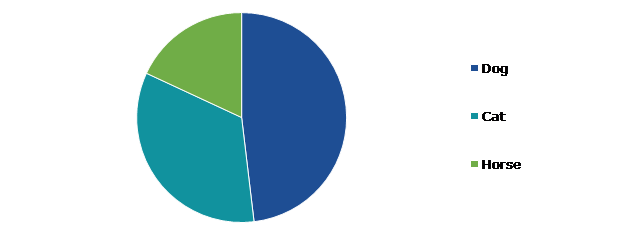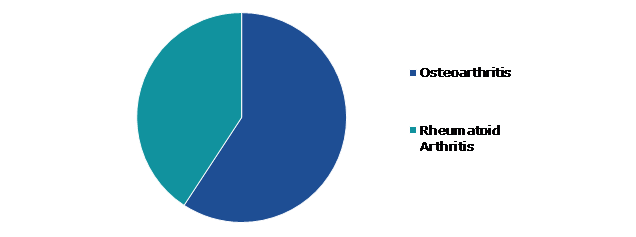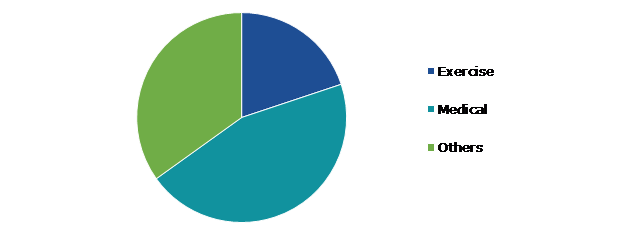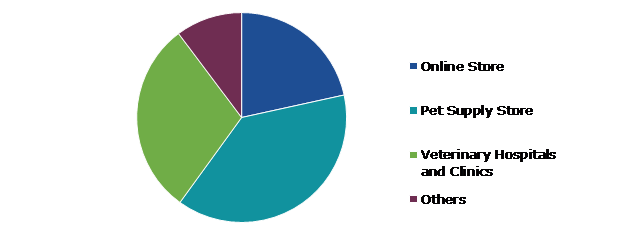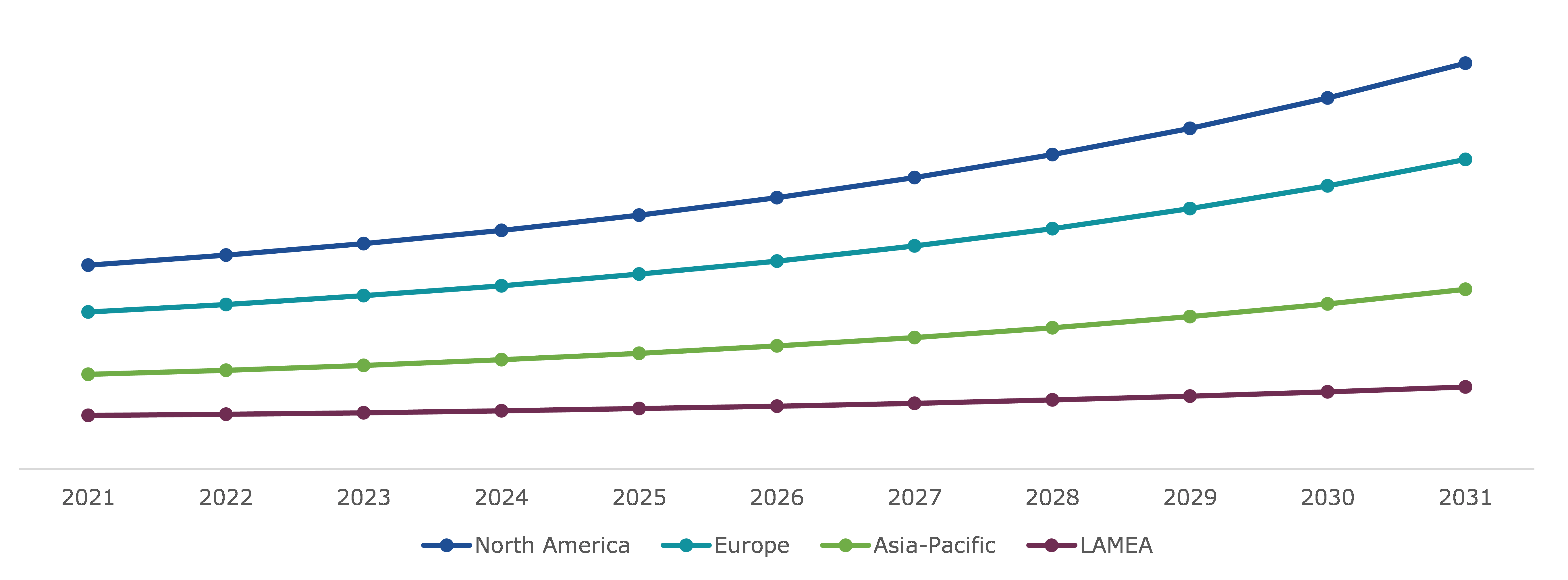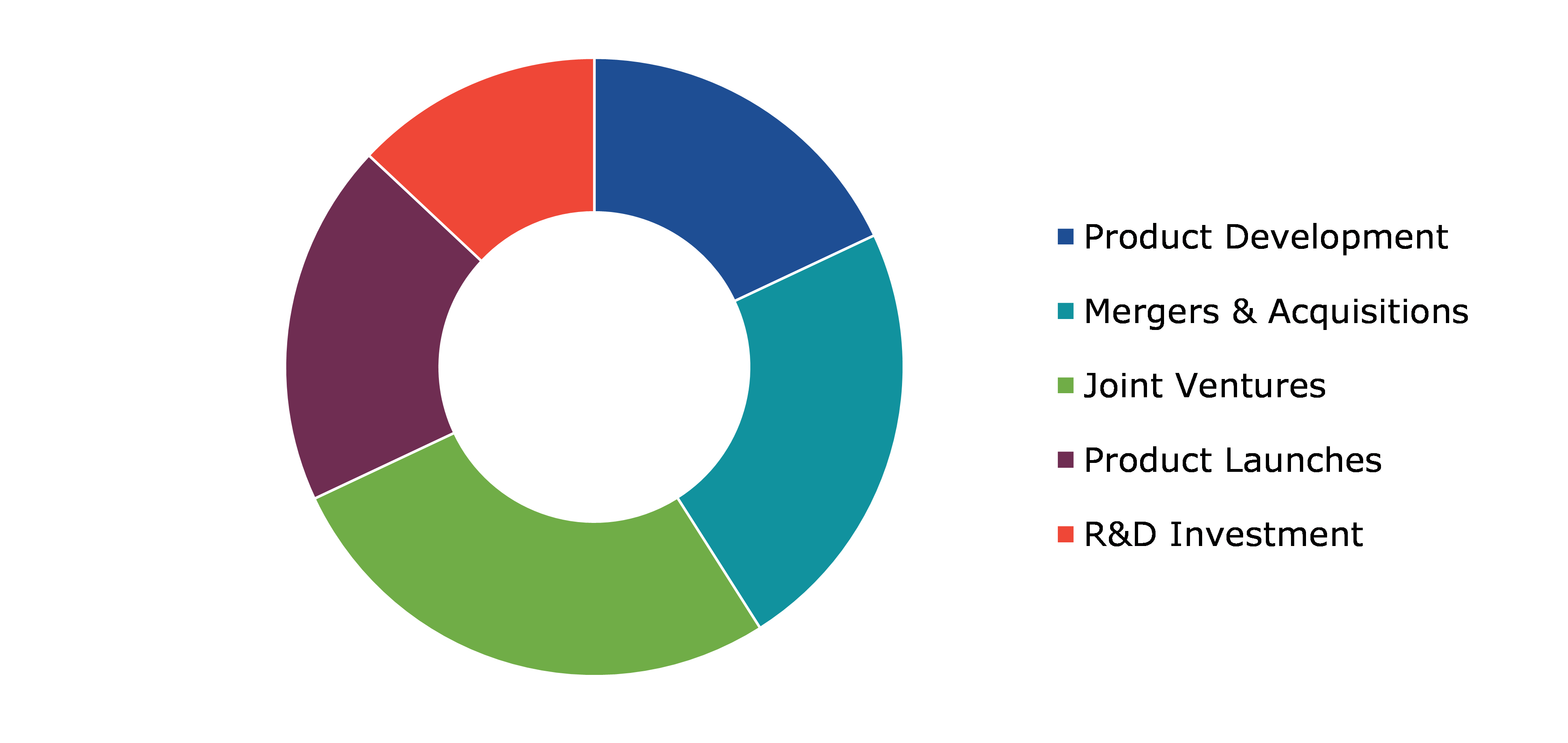Companion Animal Arthritis Market Report
RA08591
Companion Animal Arthritis Market by Companion Type (Dog, Cat, and Horse), Arthritis Type (Osteoarthritis and Rheumatoid Arthritis), Treatment (Exercise, Medical, and Others), and Distribution Channel (Online Store, Pet Supply Store, Veterinary Hospitals and Clinics, and Others): Global Opportunity Analysis and Industry Forecast, 2022–2031
Global Companion Animal Arthritis Market Analysis
The global companion animal arthritis market size was $2,875.5 million in 2021 and is predicted to grow with a CAGR of 7.0%, by generating revenue of $5,520.5 million by 2031.
Global Companion Animal Arthritis Market Synopsis
Arthritis can affect cats, dogs, and horses of all breeds as well as all ages. Osteoarthritis is one of the most common types of arthritis in companion animals and often occurs when the protective cartilage of the animal that protects the ends of the bones wears out. The most affected joints are the hips, knees, and shoulders. The injured pets as well as pets with excessive weight are more prone to arthritis. A rise in pet ownership worldwide along with an increase in pet care expenditure is anticipated to propel the companion animal arthritis market growth during the forecast time. In the U.S., the number of homes with at least one pet is at an all-time high in the year 2022, and so are pet care expenditures. Many pet owners consider their pets to be like family members and are willing to provide them with the best possible care. Cultural views are quickly transforming toward pets worldwide and with the development of pet-friendly workplaces and remote work culture, pet owners now invest more time and money in their pets’ care.
The COVID-19 outbreak created numerous challenges for the companion animal arthritis market. Less veterinary clinic admission reduced sales, and marketing activities and cancellation of routine pet check-ups hampered the market growth during the pandemic period. Animal arthritis disease is not confined to only old animals, younger animals can also be affected. When arthritis creates changes in the joint that cause discomfort, this is generally indicated by changes in the animal's behavior - the principal symptoms of the condition. As arthritis frequently develops with age, pet owners may misinterpret changes in their animal's behavior (such as a reduction in play) when the animal is suffering from severe arthritis pain.
According to regional analysis, the North America companion animal arthritis market share accounted for the highest market share in 2021. This is a result of the major presence of key players, the adoption of various strategies developed by important firms to improve market penetration, the rise in availability of treatment, the increase in rates of diagnostics, the rise in the number of pets, and the increase in the cost of pet ownership. Another factor that is anticipated to support the market growth is the rise in the number of veterinary clinics in various countries that have veterinarians that are qualified and authorized.
Companion Animal Arthritis Overview
Less excitement about going on walks, problems getting up and down, crawling, and restlessness can all be symptoms of arthritis in companion animals. Osteoarthritis is the most common type of arthritis in companion animals. Postural changes induced by spinal issues; thinning limbs from muscular atrophy; excessive licking, biting, or chewing, localized hair loss or inflammation; and low energy are also considered signs and symptoms of arthritis in companion animals. The growing companion animal population, rise in the prevalence of arthritis, increase in risk factors for the condition, government-supported awareness efforts, and methods employed by major corporations are some of the primary factors driving the industry growth.
COVID-19 Impact on Global Companion Animal Arthritis Market
The COVID-19 pandemic had a negative impact on the companion animal arthritis market growth. It has become more difficult for pet owners to obtain adequate veterinary treatment due to the cancellation and decrease of veterinary appointments caused by the pandemic. The COVID-19 pandemic created restrictions and challenges in the global companion animal health market, such as reduced sales and marketing activities, lower veterinary clinic admittance, cancellation of routine pet check-ups, and a lower number of arthritic procedures performed in veterinary facilities. However, governments and veterinary organizations in numerous nations devised plans and safety measures to recommence veterinary activity during the pandemic. According to the American Veterinary Medical Association, doctors' recommendations were extensively applied in veterinary clinics and hospitals to mitigate the consequences of lockdowns. Strict lockdowns and isolation rules were enacted globally, limiting non-essential vet visits owing to the COVID-19 pandemic. The sector, on the other hand, is expected to recover as professional business services strengthen their efforts to assist with pet care. Pet adoption and foster care applications are increasing, which is expected to help the industry prosper in the next years.
The Increase in the Prevalence of Obesity Among Companion Animals is Expected to Drive the Market Growth
Obesity is one of the major reasons attributed to arthritis in companion animals. It is caused in pets owing to excessive food intake along with a lack of physical activity. Pet owners generally consider food as a form of reward and treat their pets, which, however, contributes to overfeeding. Pets restricted to a house or small yard which are not often exercised are more prone to being overweight. In North America, obesity is the most common disorder in dogs. Around 30% of the general canine population is obese, with 40-45% of dogs aged 5-11 years old weighing in higher than normal weights. All these factors are expected to drive the companion animal arthritis market size growth during the forecast period.
To know more about global companion animal arthritis market drivers, get in touch with our analysts here.
Increase in Use of Anti-inflammatory Medicines that have various Side Effects on Animal to Restrain Market Growth
Non-steroidal anti-inflammatory medications (NSAIDs) are extensively used in veterinary medicine to treat fever, pain, and other indications of inflammation in animals. Inflammation is the body's reaction to irritation or damage, and it causes redness, warmth, swelling, and pain in the affected area. NSAIDs alleviate these problems by influencing the synthesis or function of specific chemicals produced by the body and implicated in inflammation, primarily prostaglandins. Most side effects in animals are small, but some can be dangerous and need medical attention, particularly if the medicine is not taken as directed on the label. Serious adverse effects include stomach ulcers and perforations (holes) in the intestines, kidney, and liver issues, and, in extreme circumstances, death.
Growing Demand for Companion Animal Arthritis Rapid Tests and Portable Instruments to Drive Excellent Opportunities
Portable diagnostic instruments for point-of-care (POC) services have evolved as a significant component for detecting animal illnesses in recent years. The major manufacturers in the companion animal diagnostics market are concentrating on the release of portable tools for field veterinarians. Portable systems are often utilized in distant areas, such as the patient's house or a shelter home, as well as during an emergency. The increase in need among veterinarians for on-the-spot diagnostics, and their simplicity of use in moving data from one department to the next within big veterinary hospitals and academic and research organizations, are driving the increase in usage of such tools. Rapid tests are becoming more popular among end users because of various benefits such as simplicity of use, specificity, repeatability, and low cost. These factors are projected to create numerous growth opportunities for the key players operating in the companion animal arthritis market demand.
To know more about global companion animal arthritis market opportunity, get in touch with our analysts here.
Global Companion Animal Arthritis Market, by Companion Type
By companion type, the market has been divided into dog, cat, and horse. Among these, the dog segment accounted for the highest market share in 2021, owing to an increase in dog adoption rates and high disease frequency seen among them. The rise in the number of dogs across the globe is expected to boost the market growth.
Global Companion Animal Arthritis Market Share, by Companion Type, 2021
Source: Research Dive Analysis
The dog segment accounted for the highest market share in 2021. The high prevalence of osteoarthritis across dogs is due to factors such as age, joint problems, accidents, overweight, diabetes, and past injuries. Dog arthritis is a degenerative joint condition caused by repeated rubbing, joint loss, and long-term joint disease. In animals, the most often harmed joints are knees, elbows, shoulders, hips, and spinal cord. Canine arthritis is caused by a variety of factors, including injuries, being overweight, and imperfect bone development. Globally, there has been significant growth in dog ownership, as well as a growing animal health infrastructure and treatment choices for dog arthritis.
The cat segment is anticipated to show the fastest growth during the forecast period. The growing awareness among cat owners of arthritic problems is projected to drive the segment growth. Another factor boosting the segment growth is an increase in the frequency of osteoarthritis in the cat population. According to International Cat Care (ICC), over 90% of cats, regardless of age, suffer from arthritis. However, pet owners miss the minor signs displayed by cats during the early stages of arthritis due to cats' innate ability to disguise discomfort due to their survival instinct.
Global Companion Animal Arthritis Market, by Arthritis Type
Based on arthritis type, the market has been divided into osteoarthritis and rheumatoid arthritis. Among these, the osteoarthritis segment accounted for the highest revenue share in 2021.
Global Companion Animal Arthritis Market Value, by Arthritis Type, 2021
Source: Research Dive Analysis
The osteoarthritis segment accounted for the highest market size in 2021. Osteochondrosis is a problem of bone and cartilage growth in medium and big dogs. The immature joint cartilage cracks and separates from the underlying bone in this disorder. Cysts tend to form under the cartilage if fluid enters the designated area. Cartilage fragments may dislodge from the end of a bone and float freely in the joint cavity. This causes inflammation in the afflicted joint, which can develop into arthritis and ongoing cartilage loss, limiting joint mobility significantly. The reason is unknown, but potential contributors include high-growth foods, fast development, trauma, and inheritance.
Global Companion Animal Arthritis Market, by Treatment
Based on treatment, the market has been divided into exercise, medical, and others. Among these, the medical segment accounted for the highest revenue share in 2021.
Global Companion Animal Arthritis Market Growth, by Treatment, 2021
Source: Research Dive Analysis
The medical segment accounted for the highest market size in 2021. Nonsteroidal anti-inflammatory medicines (NSAIDs) are important for managing joint discomfort and inflammation in dogs. When compared to over the counter, non-veterinary treatments, prescription drugs, such as Galli Prant, Carprofen and Meloxicam are the safest alternatives for reducing pain and inflammation.
Global Companion Animal Arthritis Market, by Distribution Channel
By distribution channel, the market has been divided into online store, pet supply store, veterinary hospitals and clinics, and others. Among these, the pet supply store segment accounted for the highest revenue share in 2021.
Global Companion Animal Arthritis Market Forecast, by Distribution Channel, 2021
Source: Research Dive Analysis
The pet supply store segment is anticipated to dominate the market during the forecast timeframe, as cats, dogs, fish, and birds remain popular house pets. Furthermore, younger pet parents, or millennial pet owners, pampered their four-legged pals with high-end food products and daycare services. Despite growing competition from supermarkets, mass merchandisers, and Internet retailers that provided more convenience and competitive prices, the industry developed substantially throughout the years, aided by good macroeconomic conditions.
Companion Animal Arthritis Market, Regional Insights
The companion animal arthritis market was investigated across North America, Europe, Asia-Pacific, and LAMEA.
Global Companion Animal Arthritis Market Size & Forecast, by Region, 2021-2031 ($ Million)
Source: Research Dive Analysis
The Market for Companion Animal Arthritis in North America to be Most Dominant
The North America companion animal arthritis market is projected to show the fastest growth owing to the presence of major players, the rise in the number of pet adoption and pet care expenditure, the adoption of numerous shares, the increase in treatment availability, and the rise in diagnostic. In addition, the rise in the number of veterinary clinics with trained veterinarians in this region is another factor likely to propel the growth of the market. In the region, obesity is the most common disorder in pets specifically dogs. Approximately 30% of the overall dog population is obese, with 40-45% of dogs aged 5-11 years old weighing in higher than average weight. All these factors are responsible for the dominating position of North America in the companion animal arthritis market revenue.
Competitive Scenario in Global Companion Animal Arthritis Market
Investment and agreement are common strategies followed by major market players. For instance, in January 2022, Zoetis got FDA clearance for Solentia, a monoclonal antibody injection in the U.S. This frunevetmab injectable is used to treat osteoarthritis pain in cats. Similarly, significant firms' new production divisions are increasing their entire industry presence.
Source: Research Dive Analysis
Some of the leading companion animal arthritis market players are Zoetis, Virbac, Elanco, Boehringer Ingelheim International GmbH, Ceva, Dechra Pharmaceuticals PLC., Vetoquinol, NexGen Pharmaceuticals, and Norbrook.
| Aspect | Particulars |
| Historical Market Estimations | 2020 |
| Base Year for Market Estimation | 2021 |
| Forecast Timeline for Market Projection | 2022-2031 |
| Geographical Scope | North America, Europe, Asia-Pacific, and LAMEA |
| Segmentation by Companion Type |
|
| Segmentation by Arthritis Type |
|
| Segmentation by Treatment |
|
| Segmentation by Distribution Channel |
|
| Key Companies Profiled |
|
Q1. What is the size of the global companion animal arthritis market?
A. The size of the global companion animal arthritis market was over $2,875.5 million in 2021 and is projected to reach $5,520.5 million by 2031.
Q2. Which are the major companies in the companion animal arthritis market?
A. Zoetis, Elanco, and Virbac are some of the key players in the global companion animal arthritis market.
Q3. Which region, among others, possesses greater investment opportunities in the near future?
A. The North America region possesses great investment opportunities for investors to witness the most promising growth in the future.
Q4. What will be the growth rate of the North America companion animal arthritis market?
A. The North America companion animal arthritis market is anticipated to grow at 7.0% CAGR during the forecast period.
Q5. What are the strategies opted by leading players in this market?
A. Agreement and investment are two key strategies opted by the operating companies in this market.
Q6. Which companies are investing more on R&D practices?
A. Dechra, Phibro Animal, and Boehringer Ingelheim, Inc. are companies investing more on R&D activities for developing new products and technologies.
1.Research Methodology
1.1.Desk Research
1.2.Real time insights and validation
1.3.Forecast model
1.4.Assumptions and forecast parameters
1.5.Market size estimation
1.5.1.Top-down approach
1.5.2.Bottom-up approach
2.Report Scope
2.1.Market definition
2.2.Key objectives of the study
2.3.Report overview
2.4.Market segmentation
2.5.Overview of the impact of COVID-19 on Global Companion Animal Arthritis market
3.Executive Summary
4.Market Overview
4.1.Introduction
4.2.Growth impact forces
4.2.1.Drivers
4.2.2.Restraints
4.2.3.Opportunities
4.3.Market value chain analysis
4.3.1.List of raw material suppliers
4.3.2.List of manufacturers
4.3.3.List of distributors
4.4.Innovation & sustainability matrices
4.4.1.Technology matrix
4.4.2.Regulatory matrix
4.5.Porter’s five forces analysis
4.5.1.Bargaining power of suppliers
4.5.2.Bargaining power of consumers
4.5.3.Threat of substitutes
4.5.4.Threat of new entrants
4.5.5.Competitive rivalry intensity
4.6.PESTLE analysis
4.6.1.Political
4.6.2.Economical
4.6.3.Social
4.6.4.Technological
4.6.5.Environmental
4.7.Impact of COVID-19 on Companion Animal Arthritis market
4.7.1.Pre-covid market scenario
4.7.2.Post-covid market scenario
5.Companion Animal Arthritis Market Analysis, by Companion Type
5.1.Overview
5.2.Dog
5.2.1.Definition, key trends, growth factors, and opportunities
5.2.2.Market size analysis, by region
5.2.3.Market share analysis, by country
5.3.Cat
5.3.1.Definition, key trends, growth factors, and opportunities
5.3.2.Market size analysis, by region
5.3.3.Market share analysis, by country
5.4.Horse
5.4.1.Definition, key trends, growth factors, and opportunities
5.4.2.Market size analysis, by region
5.4.3.Market share analysis, by country
5.5.Research Dive Exclusive Insights
5.5.1.Market attractiveness
5.5.2.Competition heatmap
6.Companion Animal Arthritis Market Analysis, by Arthritis Type
6.1.Osteoarthritis
6.1.1.Definition, key trends, growth factors, and opportunities
6.1.2.Market size analysis, by region
6.1.3.Market share analysis, by country
6.2.Rheumatoid Arthritis
6.2.1.Definition, key trends, growth factors, and opportunities
6.2.2.Market size analysis, by region
6.2.3.Market share analysis, by country
6.3.Research Dive Exclusive Insights
6.3.1.Market attractiveness
6.3.2.Competition heat map
7.Companion Animal Arthritis Market Analysis, by Treatment
7.1.Exercise
7.1.1.Definition, key trends, growth factors, and opportunities
7.1.2.Market size analysis, by region
7.1.3.Market share analysis, by country
7.2.Medical
7.2.1.Definition, key trends, growth factors, and opportunities
7.2.2.Market size analysis, by region
7.2.3.Market share analysis, by country
7.3.Other
7.3.1.Definition, key trends, growth factors, and opportunities
7.3.2.Market size analysis, by region
7.3.3.Market share analysis, by country
7.4.Research Dive Exclusive Insights
7.4.1.Market attractiveness
7.4.2.Competition heat map
8.Companion Animal Arthritis Market Analysis, by Distribution Channel
8.1.Online Store
8.1.1.Definition, key trends, growth factors, and opportunities
8.1.2.Market size analysis, by region
8.1.3.Market share analysis, by country
8.2.Pet Supply Store
8.2.1.Definition, key trends, growth factors, and opportunities
8.2.2.Market size analysis, by region
8.2.3.Market share analysis, by country
8.3.Veterinary Hospitals and Clinics
8.3.1.Definition, key trends, growth factors, and opportunities
8.3.2.Market size analysis, by region
8.3.3.Market share analysis, by country
8.4.Others
8.4.1.Definition, key trends, growth factors, and opportunities
8.4.2.Market size analysis, by region
8.4.3.Market share analysis, by country
8.5.Research Dive Exclusive Insights
8.5.1.Market attractiveness
8.5.2.Competition heat map
9.Companion Animal Arthritis Market, by Region
9.1.North America
9.1.1.U.S.
9.1.1.1.Market size analysis, by Companion Type
9.1.1.2.Market size analysis, by Arthritis Type
9.1.1.3.Market size analysis, by Treatment
9.1.1.4.Market size analysis, by Distribution Channel
9.1.2.Canada
9.1.2.1.Market size analysis, by Companion Type
9.1.2.2.Market size analysis, by Arthritis Type
9.1.2.3.Market size analysis, by Treatment
9.1.2.4.Market size analysis, by Distribution Channel
9.1.3.Mexico
9.1.3.1.Market size analysis, by Companion Type
9.1.3.2.Market size analysis, by Arthritis Type
9.1.3.3.Market size analysis, by Treatment
9.1.3.4.Market size analysis, by Distribution Channel
9.1.4.Research Dive Exclusive Insights
9.1.4.1.Market attractiveness
9.1.4.2.Competition heatmap
9.2.Europe
9.2.1.Germany
9.2.1.1.Market size analysis, by Companion Type
9.2.1.2.Market size analysis, by Arthritis Type
9.2.1.3.Market size analysis, by Treatment
9.2.1.4.Market size analysis, by Distribution Channel
9.2.2.UK
9.2.2.1.Market size analysis, by Companion Type
9.2.2.2.Market size analysis, by Arthritis Type
9.2.2.3.Market size analysis, by Treatment
9.2.2.4.Market size analysis, by Distribution Channel
9.2.3.France
9.2.3.1.Market size analysis, by Companion Type
9.2.3.2.Market size analysis, by Arthritis Type
9.2.3.3.Market size analysis, by Treatment
9.2.3.4.Market size analysis, by Distribution Channel
9.2.4.Spain
9.2.4.1.Market size analysis, by Companion Type
9.2.4.2.Market size analysis, by Arthritis Type
9.2.4.3.Market size analysis, by Treatment
9.2.4.4.Market size analysis, by Distribution Channel
9.2.5.Italy
9.2.5.1.Market size analysis, by Companion Type
9.2.5.2.Market size analysis, by Arthritis Type
9.2.5.3.Market size analysis, by Treatment
9.2.5.4.Market size analysis, by Distribution Channel
9.2.6.Rest of Europe
9.2.6.1.Market size analysis, by Companion Type
9.2.6.2.Market size analysis, by Arthritis Type
9.2.6.3.Market size analysis, by Treatment
9.2.6.4.Market size analysis, by Distribution Channel
9.2.7.Research Dive Exclusive Insights
9.2.7.1.Market attractiveness
9.2.7.2.Competition heatmap
9.3.Asia-Pacific
9.3.1.China
9.3.1.1.Market size analysis, by Companion Type
9.3.1.2.Market size analysis, by Arthritis Type
9.3.1.3.Market size analysis, by Treatment
9.3.1.4.Market size analysis, by Distribution Channel
9.3.2.Japan
9.3.2.1.Market size analysis, by Companion Type
9.3.2.2.Market size analysis, by Arthritis Type
9.3.2.3.Market size analysis, by Treatment
9.3.2.4.Market size analysis, by Distribution Channel
9.3.3.India
9.3.3.1.Market size analysis, by Companion Type
9.3.3.2.Market size analysis, by Arthritis Type
9.3.3.3.Market size analysis, by Treatment
9.3.3.4.Market size analysis, by Distribution Channel
9.3.4.Australia
9.3.4.1.Market size analysis, by Companion Type
9.3.4.2.Market size analysis, by Arthritis Type
9.3.4.3.Market size analysis, by Treatment
9.3.4.4.Market size analysis, by Distribution Channel
9.3.5.South Korea
9.3.5.1.Market size analysis, by Companion Type
9.3.5.2.Market size analysis, by Arthritis Type
9.3.5.3.Market size analysis, by Treatment
9.3.5.4.Market size analysis, by Distribution Channel
9.3.6.Rest of Asia-Pacific
9.3.6.1.Market size analysis, by Companion Type
9.3.6.2.Market size analysis, by Arthritis Type
9.3.6.3.Market size analysis, by Treatment
9.3.6.4.Market size analysis, by Distribution Channel
9.3.7.Research Dive Exclusive Insights
9.3.7.1.Market attractiveness
9.3.7.2.Competition heatmap
9.4.LAMEA
9.4.1.Brazil
9.4.1.1.Market size analysis, by Companion Type
9.4.1.2.Market size analysis, by Arthritis Type
9.4.1.3.Market size analysis, by Treatment
9.4.1.4.Market size analysis, by Distribution Channel
9.4.2.Saudi Arabia
9.4.2.1.Market size analysis, by Companion Type
9.4.2.2.Market size analysis, by Arthritis Type
9.4.2.3.Market size analysis, by Treatment
9.4.2.4.Market size analysis, by Distribution Channel
9.4.3.UAE
9.4.3.1.Market size analysis, by Companion Type
9.4.3.2.Market size analysis, by Arthritis Type
9.4.3.3.Market size analysis, by Treatment
9.4.3.4.Market size analysis, by Distribution Channel
9.4.4.South Africa
9.4.4.1.Market size analysis, by Companion Type
9.4.4.2.Market size analysis, by Arthritis Type
9.4.4.3.Market size analysis, by Treatment
9.4.4.4.Market size analysis, by Distribution Channel
9.4.5.Rest of LAMEA
9.4.5.1.Market size analysis, by Companion Type
9.4.5.2.Market size analysis, by Arthritis Type
9.4.5.3.Market size analysis, by Treatment
9.4.5.4.Market size analysis, by Distribution Channel
9.4.6.Research Dive Exclusive Insights
9.4.6.1.Market attractiveness
9.4.6.2.Competition heatmap
10.Competitive Landscape
10.1.Top winning strategies, 2021
10.1.1.By strategy
10.1.2.By year
10.2.Strategic overview
10.3.Market share analysis, 2021
11.Company Profiles
11.1.Zoetis
11.1.1.Overview
11.1.2.Business segments
11.1.3.Product portfolio
11.1.4.Financial performance
11.1.5.Recent developments
11.1.6.SWOT analysis
11.2.Elanco
11.2.1.Overview
11.2.2.Business segments
11.2.3.Product portfolio
11.2.4.Financial performance
11.2.5.Recent developments
11.2.6.SWOT analysis
11.3.Virbac
11.3.1.Overview
11.3.2.Business segments
11.3.3.Product portfolio
11.3.4.Financial performance
11.3.5.Recent developments
11.3.6.SWOT analysis
11.4.Dechra
11.4.1.Overview
11.4.2.Business segments
11.4.3.Product portfolio
11.4.4.Financial performance
11.4.5.Recent developments
11.4.6.SWOT analysis
11.5.Vetoquinol
11.5.1.Overview
11.5.2.Business segments
11.5.3.Product portfolio
11.5.4.Financial performance
11.5.5.Recent developments
11.5.6.SWOT analysis
11.6.Phibro Animal
11.6.1.Overview
11.6.2.Business segments
11.6.3.Product portfolio
11.6.4.Financial performance
11.6.5.Recent developments
11.6.6.SWOT analysis
11.7.Boehringer Ingelheim
11.7.1.Overview
11.7.2.Business segments
11.7.3.Product portfolio
11.7.4.Financial performance
11.7.5.Recent developments
11.7.6.SWOT analysis
11.8.NexGen Pharmaceuticals
11.8.1.Overview
11.8.2.Business segments
11.8.3.Product portfolio
11.8.4.Financial performance
11.8.5.Recent developments
11.8.6.SWOT analysis
11.9.Ceva
11.9.1.Overview
11.9.2.Business segments
11.9.3.Product portfolio
11.9.4.Financial performance
11.9.5.Recent developments
11.9.6.SWOT analysis
11.10.Ceva
11.10.1.Overview
11.10.2.Business segments
11.10.3.Product portfolio
11.10.4.Financial performance
11.10.5.Recent developments
11.10.6.SWOT analysis
12.Appendix
12.1.Parent & peer market analysis
12.2.Premium insights from industry experts
12.3.Related reports
Arthritis, especially osteoarthritis, is one of the most common ailments that companion animals like dogs, cats, and horses suffer from. Osteoarthritis results in the wearing out of the protective cartilage that covers the ends of the bones of animals. Though all the bones of the animal body are affected, osteoarthritis primarily affects the joints of knees, shoulders, and hip. Changes in animal behaviour are considered to be the main symptom of osteoarthritis. Contrary to the common idea, osteoarthritis can also develop in animals at a younger age also.
Forecast Analysis of the Companion Animal Arthritis Market
According to the report published by Research Dive, the global companion animal arthritis market is expected to gather a revenue of $5,520.5 million by 2031 and grow at 7.0% CAGR in the 2022–2031 timeframe. In the recent years, there has been an increase in the adoption of pets across the globe. This global growth in pet ownership is expected to be the primary growth driver of the global market in the coming years. Along with this, an overall increase in the pet care expenditure is expected to push the companion animal arthritis market further. Also, the increase in prevalence of obesity in companion animals is predicted to offer numerous investment and growth opportunities to the market in the analysis timeframe, 2022–2031. However, growing use of anti-inflammatory medicines, which have numerous side effects, may restrain the growth of the market in the forecast period.
Regionally, the companion animal arthritis market in the North America region is expected to be the most dominant and have the fastest growth rate by 2031. An increase in the overall adoption of pets and growing pet expenditure are expected to become the two main growth drivers of the market in this region during the forecast period. Some prominent market players include Zoetis, Ceva, Vetoquinol, Virbac, Norbrook, Boehringer Ingelheim International GmbH, Dechra Pharmaceuticals PLC., Elanco, NexGen Pharmaceuticals, and many others.
Significant Market Developments
The significant companies operating in the industry are adopting numerous growth strategies & business tactics such as partnerships, collaborations, mergers & acquisitions, and launches to maintain a robust position in the overall market, thus helping the companion animal arthritis market to flourish. For instance:
- In March 2021, Morris Animal Foundation, an animal health charity based in the US, announced that it was partnering with Elanco Animal Health Incorporated, a leading pharmaceutical company specializing in pets vaccines. The partnership by Morris Animal Foundation is aimed at getting better insights and understanding with respect to the nature of osteoarthritis and how it affects pets in general.
- In June 2022, The Dômes Pharma Group, a leading pharmaceutical company, announced that it was partnering with EquiCord, a global biotech company. This partnership is aimed at developing the world’s first stem cell-based drug to treat canine osteoarthritis. The partnership will help both companies to integrate their resources and work together in a coherent manner to develop the drug at the earliest.
- In September 2022, Zoetis, a global animal health company, announced that it had signed an acquisition agreement with NewMetrica, a company developing instruments that help in measuring the quality of life in animals. This acquisition is expected to help the acquiring company, i.e., Zoetis to substantially increase its foothold in the market in the coming period.
Covid-19 Impact on the Companion Animal Arthritis Market
The outbreak of the Covid-19 pandemic has had a massive negative effect on almost all industries and businesses across the world. The companion animal arthritis market faced a similar fate due to the pandemic. Due to the Covid-19 outbreak, it became difficult for pet owners to get an appointment with veterinary doctors. Also, there was an overall decrease in routine pet check-ups, thereby reducing the number of arthritis procedures being conducted on companion animals. These factors led to a decline in the overall growth rate of the market.
Personalize this research
- Triangulate with your own data
- Request your format and definition
- Get a deeper dive on a specific application, geography, customer or competitor
- + 1-888-961-4454 Toll - Free
- support@researchdive.com

